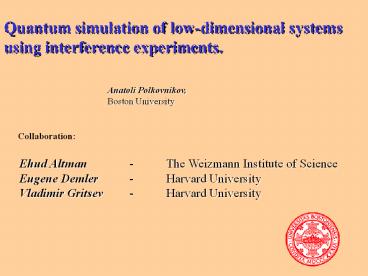Quantum simulation of low-dimensional systems using interference experiments. PowerPoint PPT Presentation
Title: Quantum simulation of low-dimensional systems using interference experiments.
1
Quantum simulation of low-dimensional systems
using interference experiments.
Anatoli Polkovnikov, Boston University
Collaboration
Ehud Altman - The Weizmann Institute of
Science Eugene Demler - Harvard
University Vladimir Gritsev - Harvard
University
2
Quantum Simulations
- Universal can simulate any unitary evolution
- Simulating specific (interacting) Hamiltonians
- direct simulate the system we realize
- Indirect simulate one system realizing another
one.
This talk simulating a quantum impurity model
in a 1D interacting Fermi gas using interference
between homogeneous 1D bosons.
3
This talk
- Interference between two systems of interacting
bosons - measurements and interference
- shot noise
- noise due to phase fluctuations
- full distribution function and quantum
simulations - outlook.
4
Interference between two condensates.
5
What do we observe?
Y. Castin and J. Dalibard, 1997
6
(No Transcript)
7
P. Anderson, 1984, Do two superfluids which have
never seen one another possess a definitive
phase? Y. Castin and J. Dalibard, 1997 for a
specific gedanken experiment yes but this phase
is spontaneously generated by measurement!!! A.P.,
E. Altman and E. Demler, 2005 yes for ToF
experiments.
8
How do we analyze the image?
9
Define an observable (interference amplitude
squared )
10
Extended condensates.
This talk how to analyze this reduction of the
contrast.
11
Fluctuating Condensates.
12
Scaling with L two limiting cases
13
Formal derivation
14
Intermediate case (quasi long-range order).
1D condensates (Luttinger liquids)
z
Repulsive bosons with short range interactions
Finite temperature
15
Angular Dependence.
16
Two-dimensional condensates at finite temperature
(picture by Z. Hadzibabic)
17
Observing the Kosterlitz-Thouless transition
Above KT transition
18
Zoran Hadzibabic, Peter Kruger, Marc Cheneau,
Baptiste Battelier, Sabine Stock, and Jean
Dalibard (2006).
19
Z. Hadzibabic et. al.
universal jump in the superfluid density
c.f. Bishop and Reppy
20
Higher Moments.
is an observable quantum operator
21
Sketch of the derivation
Action
22
Two simple limits
Strongly interacting Tonks-Girardeau regime
Central limit theorem! Also at finite T.
23
Connection to the impurity in a Luttinger liquid
problem.
Boundary Sine-Gordon theory
P. Fendley, F. Lesage, H. Saleur (1995).
Same integrals as in the expressions for
(we rely on Euclidean invariance).
24
Experimental simulation of the quantum impurity
problem
- Do a series of experiments and determine the
distribution function.
- Read the result.
25
Relevance of the boundary SG model to other
problems.
An isolated impurity in a 1D Fermi gas.
scattering on impurity
interacting electron gas
Klt1, attractive interactions impurity is
relevant
Kgt1, repulsive interactions impurity is
irrelevant
Kane and Fisher, 1992
We can directly simulate the partition function
for this problem in interference experiments.
26
Interacting flux lines in 2D superconductors.
h? plays the role of the relative momentum q
I. Affleck, W. Hofstetter, D. R. Nelson, U.
Schollwock, J.Stat.Mech. 0410 P003 (2004)
27
can be found using Bethe ansatz methods for half
integer K.
In principle we can find W
Difficulties need to do analytic continuation.
The problem becomes increasingly harder as K
increases.
Use a different approach based on spectral
determinant
Dorey, Tateo, J.Phys. A. Math. Gen. 32L419
(1999) Bazhanov, Lukyanov, Zamolodchikov, J.
Stat. Phys. 102567 (2001)
28
Evolution of the distribution function.
29
Universal Gumbel distribution at large K
(?-1)/??
30
Generalized extreme value distribution
31
Extension direct probing of fermionic
superfluidity
32
Conclusions.
- Analysis of interference between independent
condensates reveals a wealth of information about
their internal structure. - Shot noise and phase fluctuations are responsible
for decrease of the interference contrast. Shot
noise is subdominant in large systems with
(quasi) long range order. - Scaling of interference amplitudes with L or ?
reveals correlation function exponents. - Probability distribution of amplitudes gives the
information about higher order correlation
functions. - Interference of two Luttinger liquids allows one
to obtain partition function of a 1D quantum
impurity problem (also related to variety of
other problems) and thus to simulate it.
Extensions to other cases fermions, out of
equilibrium systems, spin systems, etc.
33
Quench experiments in 1D and 2D systems
T. Schumm . et. al., Nature Physics 1, 57 - 62
(01 Oct 2005)
Study dephasing as a function of time. What sort
of information can we get?
34
(No Transcript)
35
Excitations solitons and breathers.
solitons
Can create solitons only in pairs. Expect damped
oscillations
36
Analogy with a Josephson junction.
En
soliton pairs (only with q?0)
breathers
f
37
Numerical simulations
Hubbard model, 2 chains, 6 sites each
b02
b24
2s01
b46
b04
2b02
b26
Fourier analysis of the oscillations is a way to
perform spectroscopy.
38
Quench in 2D condensates
Expect a very sharp change in TKT as a function
of the layer separation.
39
RG calculation for various values of vortex
fugacity. Neglect dependence ?c(T).
40
Angular (momentum) Dependence.

